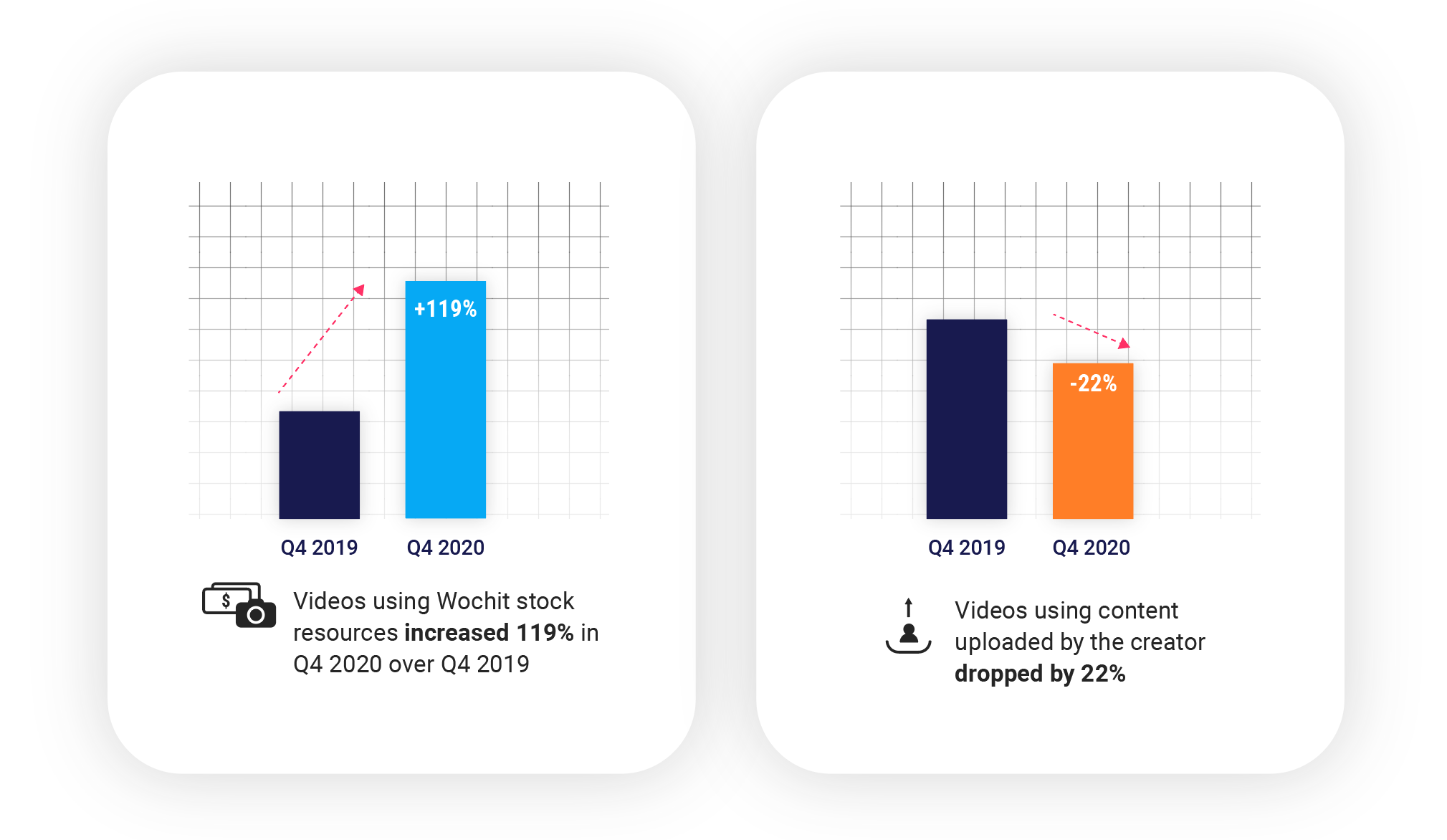
We took a deep dive into hundreds of thousands of videos created on our platform to find some interesting video creation trends, and the data didn’t disappoint. Here are some of our most interesting findings.
Video is still growing—and more people are making them
Video creation in our platform saw a significant rise over the past year. Our data shows: A huge portion of this increase comes from enterprise brands, which multiplied their production by a full 86%. Meanwhile, publishers and non-profits saw increases in production at 29% and 21%, respectively.
A huge portion of this increase comes from enterprise brands, which multiplied their production by a full 86%. Meanwhile, publishers and non-profits saw increases in production at 29% and 21%, respectively.
What’s behind the increase in production? We’ve seen an expansion in the types of people creating videos.
More people within the organizations, in various roles, are now editing and communicating with video, particularly in NGOs and enterprise brands. The people who are making videos are no longer limited to a highly-skilled video team—they’re communicators without a background in video production.
Myriam Ferrus, Voici’s Editor in Chief of Digital, Videos and Social, explains:
I am no technician. I am a journalist. I have been working for TV and radio as a journalist for 20 years. During my career, I edited thousands of videos…with the help of an editor using Premiere or Final Cut sitting next to me listening to my orders. When I started using Wochit, I realized that I could create my own videos and that I was finally ‘free’ and could make quality videos at scale.
YouTube reports similar findings: “The creator archetype is evolving to match an audience more open to diverse stories and storytellers.” From seniors to indigenous rappers, more people are creating videos. And we expect to see this trend continue in 2021 as more brands adopt video creation to tell their stories.
Video creators are relying heavily on stock
When it comes to the type of content being used by creators, we saw a big increase in the use of stock video and imagery in 2020, compared to 2019.
 A likely explanation for this decrease in original source content? The pandemic.
A likely explanation for this decrease in original source content? The pandemic.
Around the world, people are largely staying home. This includes the video crews that would typically be out and about capturing new video content, as well as the people that would be featured in it. With this in mind, we expect that this is one of the video creation trends to persist into 2021.
On the topic of video content sources, we also noticed that 50% of the content used is still images rather than moving video—which goes to show that video footage is not necessary to create engaging video content.
> Video with photos only: from Fox News
Video aspect ratios are evolving—depending on the goal
What aspect ratios are most popular when it comes to video creation? And is this changing over time? We found a clear distinction between organizations that monetize their videos and those that don’t.
16:9 video holds steady, especially for publishers
The 16:9 (wide screen) remains the primary video aspect ratio with traditional media, and their use of this format increased about 9% from 2019 to 2020. This is probably due to the fact that these publishers need to monetize their videos and—after being hurt by Facebook’s algorithm change a few years back—they trust their own websites as the best place to do so.
These media organizations largely publish on YouTube and embed the video in their own websites, monetized with ads—and both YouTube and ad inventory tend to be produced in 16:9.
> 16:9 video: from Milenio
On the other hand, enterprise brands decreased the use of landscape video by 26%. Brands and non-profits often measure success by reach and engagement and do not have the same pressure to monetize their videos. They’re happy to ‘give away’ their content to take advantage of the large audiences on social media—it’s in their interest to spread their message as far and wide as possible. More exposure, higher ROI.
9:16 video is used less by publishers but embraced by brands
Conversely, our video production data shows a general trend away from the vertical 9:16 aspect ratio, with 37% fewer videos produced in these dimensions in 2020. This is likely because there are still few options to monetize vertical video through programmatic adverts on platforms that favor the Stories format. However, IGTV has promised this option for some time and began testing IGTV ads with a small group of creators and advertisers in the US in 2020. Watch this space for 2021.
Enterprise brands and non-profits, who are often driven by reach and engagement, produced far more videos in the 9:16 aspect ratio in 2020 than 2019. We attribute the 371% increase in this format to the meteoric rise of the Stories format, which is now available across all of the major social platforms—Instagram, Facebook, Snapchat, TikTok, LinkedIn, and most recently Twitter’s “Fleets”.
> 9:16 video: from MSC
@msc_fischWer von euch hat schonmal Seegurken probiert?🤔💙Sie sind nicht nur gesund, sondern leisten auch einen wichtigen Teil zum Ökosystem des Meeres! #meer♬ Originalton – MSC DE
4:5 video grows at the expense of 1:1
The 4:5 aspect ratio is a new format favored by Instagram for its in-feed content and, to some extent, Facebook too. While production in this format remained low overall, we saw growth at the wild rate of 567% over the year—mostly at the expense of the 1:1 aspect ratio, which was down 31%.
 We expect the trend to embrace 4×5 to continue this year. In fact, Facebook’s internal research showed an improvement in engagement when videos were switched from 16:9 to 4:5, and their advice is clear:
We expect the trend to embrace 4×5 to continue this year. In fact, Facebook’s internal research showed an improvement in engagement when videos were switched from 16:9 to 4:5, and their advice is clear:
We live in a world where most people watch videos on mobile just inches from their face and often in vertical orientation rather than turning their phone to landscape. Try framing your visual story and build for vertical format. Editing your videos using a 4:5 aspect ratio may work best for your videos on Facebook.
As this new format started to take hold, European broadcaster Mediaset and Wochit teamed up to study which of these aspect ratios worked best. They found that portrait outperformed square on Facebook:
• Views: 147% ↑
• Reactions: 69% ↑
• Comments: 107% ↑
> 4:5 video: from TVNorge / Discovery
Creators are optimizing formats for each platform
As it became clear that aspect ratio has an impact on performance, Wochit creators are increasingly using the clone feature to resize their videos to different aspect ratios, in order to optimize posts for the respective platform. Use of this functionality grew by 19% in Q4 2020 over Q4 2019
Most of this increase came from publishers. While publishers had record views on site in 2020, many reported lower revenue from ads as a result of the pandemic. It’s possible that with fewer options to make money on their videos, these creators took advantage of the opportunity to grow their audience using social—which would require duplicating content in a variety of aspect ratios.
> Aspect ratio conversion: from Eurosport

Brands are creating videos in less time
As video creation solutions are making it easier to produce video content, we saw the amount of time it takes to produce a video go down in Q4 2020 (over the same time in 2019).
 However, these video production statistics differed by industry.
However, these video production statistics differed by industry.
While enterprise brands and publishers both seem to be creating more videos in less time, non-profits are taking their time to create fewer, longer videos. Non-profits therefore saw a bit less growth in the sheer volume of videos produced, as well as a smaller decrease in video production time. This difference is likely explained by the emotional, human stories non-profits often tell to generate awareness of and interest in their causes—which lend themselves to longer-form content.

Fun video facts
Music mood
You might think video produced in 2020 would have a gloomier mood than video from pre-pandemic days, but our creators dashed this assumption.
Most popular video content searches
Searches for stock image and video content, however, did see some fluctuation between 2019 and 2020.

Enjoy these video trends?
There’s more where that came from. We plan to keep an eye on these statistics and video production trends throughout 2021 and beyond, and we’ll share them with you here. Follow us for updates!




